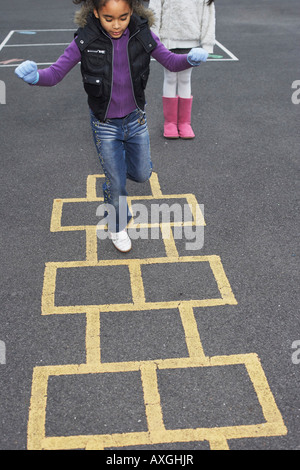

Hop and jump your way up the course from 1 to 10, skipping the square with the marker.In a row with only one square, you may only land with one foot. If two squares are next to each other, land with both feet on the ground, one foot per square.You can only place one foot on a square at a time.If the marker lands on the first square, your turn begins.You get two tries to toss the marker into square one.The goal is to make it up and back from square 1 to square 10 while playing by the following hopscotch rules: Indoors, use painter’s tape to create a board and a checkers game piece for the marker. What you need to play hopscotchĪll you need to play hopscotch outdoors is a stick to draw in the dirt or chalk to write on the pavement, and a stone to use as your marker. There are many variations, but a standard board starts with the number 1 in front, 2 and 3 next to each other, 4 alone, 5 and 6 on the same line, 7 alone, 8 and 9 next to each other and finally 10 at the end. If it’s not fun they’re not going to do it,” Myer adds. Teaching games like hopscotch gives your kids a go-to strength-building activity they can play alone or in groups anytime and anywhere.

Greg Myer, the director of the Human Performance Lab and director of research at the division of sports medicine at Cincinnati Children’s Hospital Medical Center. “To create ideal movement patterns, children need a basal level of strength,” says Dr. A game like hopscotch makes children jump and bend in quick bursts of energy, which is how children naturally play. Kids crave movement and activity, and they need it for their physical development. “No matter how athletic you are, you don’t know exactly where the tossed object will land, and no matter how lucky you are, you have to be coordinated.” “I often hear it described as a girls’ game, but in my Boston neighborhood, growing up in the ’70s, boys and girls both played because it combines coordination with a random factor,” says Joshua Glenn, the co-author of the “ UNBORED” activity books and activities. It’s easy to learn, gets kids outside, involves some level of physical challenge and can be played by everyone. Played on painted courts in the school ground At School 05īoy goes through the paces of playing hopscotch on hopscotch pattern.Hopscotch rules are simple, but variations can add fun twists and new challenges to the game. Props: Hopscotch Court, Play not observed, but the courts were drawn in chalk. Other informants mentioned throwing a dice and hopping to the square shown on the dice. They explained that they might throw the stone, or beanbag into a square and then hop all the way to the other end and pick up the object on their way back. The students describe the patterns they use and eventually the variations of taw they used although they were not familiar with the expression 'taw'. Props: Chalk, taw (stone, stick, woodchip),

They did not use a 'taw', and were just hopping from one number to another and out the other end. At School 08Ī boy and a girl were playing Hopscotch in the extra-long hopscotch pattern painted on the ground. It appeared that this was a half remembered hybrid, more jumping than organised movements. Props: Hopscotch Court, Stones, sticks, flowersĬhildren are forbidden to pick up sticks At School 07Ĭlassic game of hopscotch whereby a small rock is used as taw and participants begin by throwing taw into first section of 'area' and hopping over it and progressing along the 'area', etc At School 15 The principal explained that the school didn't like giving the children chalk because of the mess it would leave - they tended to use it under the covered areas where it didn't wash off when it rained. The current painted configurations were painted at the beginning of this year- under and beside this configuration was a faded previous painted version- and perhaps more interesting was a chalk drawn version created underneath the covered area of the playground.


 0 kommentar(er)
0 kommentar(er)
